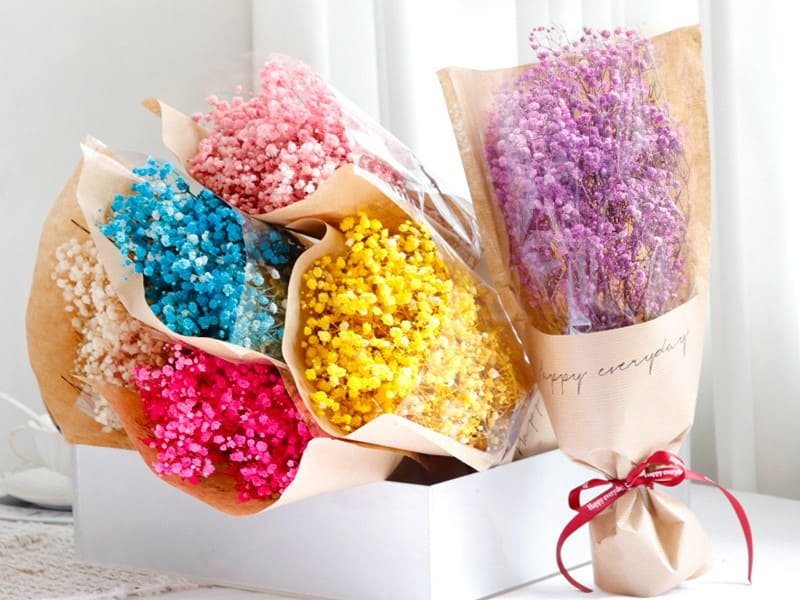Creating a dried Gypsophila (Baby’s Breath) shadow box is a beautiful and sentimental project that can preserve memories and add a touch of natural elegance to any space. Whether you’re looking to commemorate a special event, create a unique piece of art, or simply enjoy the delicate beauty of dried flowers, a Gypsophila shadow box is a perfect choice. This detailed guide will take you through the entire process, from selecting and drying the flowers to arranging and securing them in the shadow box, ensuring a stunning final result.
1. Understanding Gypsophila (Baby’s Breath)
Before diving into the process, it’s important to understand why Gypsophila is an ideal choice for a shadow box.
- Delicate Beauty: Gypsophila, commonly known as Baby’s Breath, is renowned for its small, delicate flowers that add a soft, romantic touch to floral arrangements. Its airy appearance makes it an excellent choice for a shadow box where the focus is on preserving a light, ethereal look.
- Symbolism: Baby’s Breath is often associated with purity, innocence, and everlasting love. These meanings make it a popular choice for weddings, christenings, and other significant life events, making a Gypsophila shadow box a meaningful keepsake.
- Ease of Drying: Gypsophila is relatively easy to dry and maintains its shape and color well when properly preserved. This durability ensures that your shadow box will remain beautiful for years to come.
2. Gathering Your Materials
Creating a dried Gypsophila shadow box requires a few key materials. Here’s a list of what you’ll need:
- Fresh Gypsophila: Start with fresh Gypsophila, as it will need to be dried before use. You can purchase it from a florist, or, if you have it in your garden, cut fresh stems.
- Shadow Box Frame: Choose a shadow box that suits your style and the size of your project. Shadow boxes are available in various sizes and depths, so select one that allows enough space for the flowers without squishing them.
- Drying Materials: You’ll need silica gel (optional) or just air-drying materials like string and hangers for drying the flowers.
- Glue or Floral Adhesive: A strong, clear-drying glue or floral adhesive is essential for securing the dried Gypsophila inside the shadow box.
- Decorative Elements: Consider adding background paper, fabric, or other decorative elements to enhance the visual appeal of your shadow box.
- Scissors and Tweezers: These tools will help you trim the flowers and place them precisely within the shadow box.
3. Drying the Gypsophila
Drying the Gypsophila properly is crucial for ensuring that it looks beautiful in your shadow box. There are two common methods for drying Baby’s Breath: air drying and using silica gel.
Air Drying Method
Air drying is the simplest and most traditional method for drying flowers.
- Gather Fresh Stems: Start by cutting fresh Gypsophila stems. Remove any excess foliage, as you’ll only want the flowers in your shadow box.
- Bundle and Tie: Gather the stems into small bundles and tie them together with string or rubber bands.
- Hang Upside Down: Hang the bundles upside down in a cool, dark, and dry place. A closet or attic is often ideal. Ensure there is good air circulation to prevent mold.
- Wait for 1-2 Weeks: Leave the flowers to dry for 1-2 weeks. They are ready when they feel dry to the touch and maintain their shape.
Silica Gel Drying Method
For a faster drying process that retains more color, you can use silica gel.
- Prepare the Silica Gel: Spread a layer of silica gel in an airtight container.
- Place the Flowers: Lay the Gypsophila stems on top of the gel and then gently cover them with more silica gel. Be careful not to crush the delicate flowers.
- Seal and Wait: Seal the container and leave it for 3-7 days, depending on the moisture content of the flowers.
- Remove and Clean: Once dried, carefully remove the flowers from the gel and gently brush off any excess particles.
4. Preparing the Shadow Box
While your Gypsophila is drying, you can prepare the shadow box to ensure it’s ready for when the flowers are dried.
Choosing a Background
The background of your shadow box is an important element that can enhance the beauty of the dried Gypsophila.
- Neutral Background: A neutral background like white, beige, or light gray will highlight the delicate flowers without overwhelming them.
- Textured Background: Consider using fabric, lace, or textured paper for a more dynamic appearance. The texture can add depth and interest to the arrangement.
- Colored Background: If you want to create contrast, choose a background color that complements the Gypsophila’s white or pale pink hue.
Securing the Background
Once you’ve chosen your background, secure it to the back panel of the shadow box.
- Measure and Cut: Measure the inside of the shadow box and cut the background material to fit.
- Adhere to the Back Panel: Use glue, double-sided tape, or adhesive spray to attach the background material securely to the back panel.
5. Arranging the Dried Gypsophila
With your flowers dried and shadow box prepared, it’s time to arrange the Gypsophila inside the box.
Planning the Layout
Before gluing anything down, plan the layout of the flowers. You can create a design on paper or arrange the flowers loosely in the shadow box to get an idea of how they’ll look.
- Simple Cluster: A simple cluster of Gypsophila in the center of the shadow box can create an elegant focal point.
- Scattered Design: For a more whimsical look, scatter small clusters of Gypsophila across the shadow box.
- Layered Arrangement: Layer the flowers to create depth, placing some closer to the glass and others further back.
Securing the Flowers
Once you’re satisfied with the arrangement, it’s time to secure the flowers.
- Trim the Stems: Use scissors to trim the stems to the desired length.
- Apply Glue: Apply a small amount of glue to the base of each stem or directly to the background where the stem will be placed. Use tweezers to carefully position the flowers, pressing gently to secure them.
- Hold in Place: If needed, use pins or clips to hold the flowers in place until the glue dries completely.
6. Adding Decorative Elements
To personalize your shadow box, consider adding decorative elements that complement the Gypsophila.
Incorporating Text or Mementos
You can add text or small mementos to make the shadow box even more special.
- Text: Print or write a meaningful quote, date, or name to include in the shadow box. This could be related to the event the flowers commemorate or simply a phrase that adds to the sentimentality.
- Mementos: Incorporate small items such as a piece of jewelry, a ribbon, or a photograph. These items can be arranged alongside the flowers to create a more personalized piece.
Enhancing with Additional Flora
While Gypsophila is beautiful on its own, you might want to add other dried flowers or greenery to complement it.
- Greenery: Small sprigs of dried greenery like eucalyptus or ferns can add contrast and texture to the arrangement.
- Complementary Flowers: Consider adding a few other dried flowers, such as lavender or roses, to enhance the visual appeal.
7. Final Assembly and Display
With everything in place, it’s time to finalize the shadow box and prepare it for display.
Assembling the Shadow Box
Carefully place the back panel with the secured flowers and background into the shadow box frame.
- Secure the Back Panel: Use the fasteners provided with the shadow box to secure the back panel in place. Ensure it’s tightly fitted to prevent any movement.
- Clean the Glass: Before sealing the shadow box, clean the glass inside and out to remove any fingerprints or dust.
Choosing the Display Location
Consider where you’ll display your Gypsophila shadow box to ensure it’s showcased in the best possible light.
- Natural Light: Displaying the shadow box in a location with natural light will highlight the delicate details of the Gypsophila. However, avoid direct sunlight, which can cause the flowers to fade over time.
- Complementary Decor: Place the shadow box in a location where it complements other decor elements. It can be the focal point on a gallery wall or a standalone piece on a shelf.
- Protective Placement: Ensure the shadow box is placed in a location where it won’t be easily knocked over or damaged.
8. Maintenance and Care
To keep your dried Gypsophila shadow box looking beautiful for years to come, follow these maintenance tips:
- Dust Regularly: Gently dust the shadow box using a soft, dry cloth or a can of compressed air to prevent dust buildup.
- Avoid Humidity: Keep the shadow box in a dry environment to prevent moisture from damaging the dried flowers.
- Check for Damage: Periodically inspect the shadow box for any signs of damage or loosening of the flowers. If needed, make minor repairs with glue.
Conclusion
Creating a dried Gypsophila shadow box is a rewarding project that allows you to preserve the delicate beauty of Baby’s Breath in a meaningful and artistic way. Whether commemorating a special occasion or simply enjoying the natural elegance of dried flowers, a shadow box is a timeless piece that can enhance any space. By carefully selecting, drying, and arranging Gypsophila, and possibly incorporating additional elements like text, other flowers, or mementos, you can craft a unique and personal work of art that will be cherished for years.
This project not only offers a creative outlet but also provides a lasting keepsake that celebrates the enduring beauty of nature. Whether you choose a simple design or a more complex arrangement, the process of creating a dried Gypsophila shadow box is a meditative and fulfilling experience. Display your finished shadow box proudly, and let it serve as a reminder of the moments, people, and memories it represents.
With proper care and maintenance, your shadow box will remain a beautiful and meaningful addition to your home, allowing you to enjoy the delicate charm of Gypsophila long after the flowers have bloomed.




